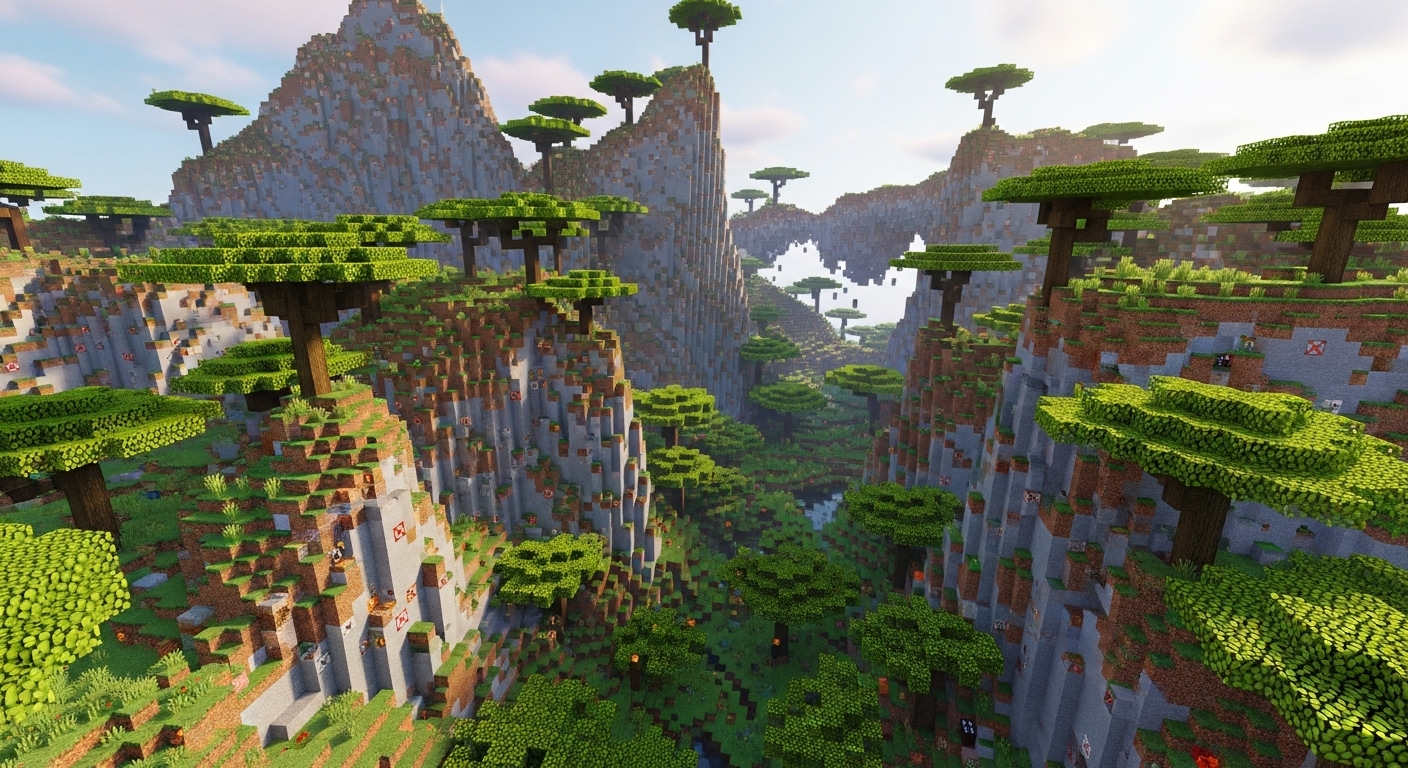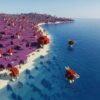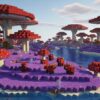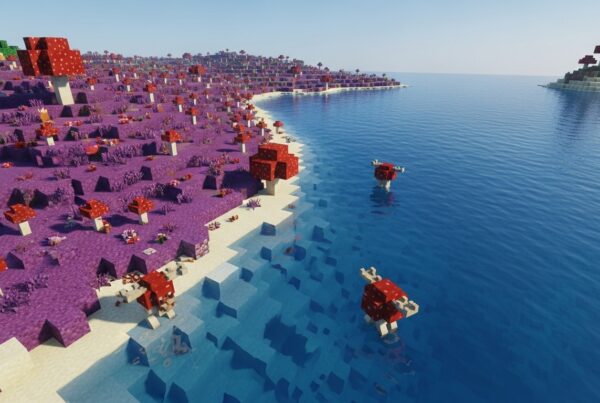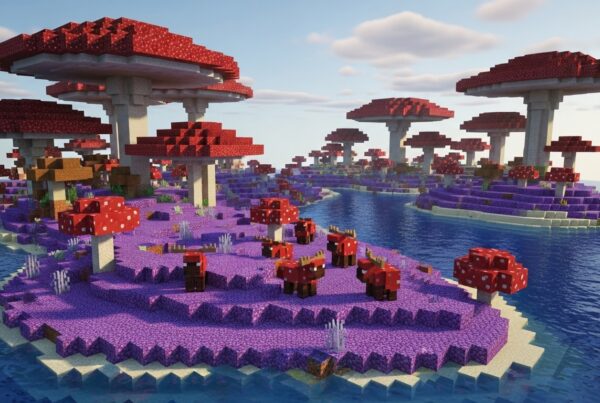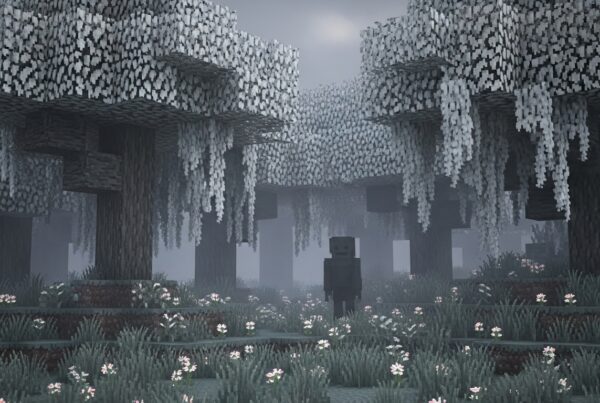The Windswept Savanna is one of Minecraft’s most striking and rare warm biomes. Known for its towering cliffs, dramatic stone peaks, and unusually tall acacia trees, this biome blends the warm palette of the savanna with the extreme terrain of windswept landscapes. Its rugged hills and chaotic formations offer both opportunities and challenges for explorers, builders, and survivalists.
This complete guide covers everything you need to know about the Windswept Savanna, including terrain features, mob behavior, survival tips, building ideas, biome-finding strategies, and Java/Bedrock seed recommendations.
What Is the Windswept Savanna Biome?
The Windswept Savanna is a warm, hilly biome that merges elements of the standard Savanna with the rugged cliffs found in Windswept Hills. It stands out due to:
- Extremely sharp elevation changes
- Tall, stretched acacia trees growing on mountain faces
- Exposed stone, gravel, and coarse dirt
- A warm, arid color palette unique to savanna variants
This biome is rare, often appearing in warm climate bands near Savanna, Windswept Hills, Badlands, and Desert biomes. Its wild terrain makes it dramatically different from the flat savannas most players recognize.
Biome Appearance and Terrain Features
Steep Cliffs, Peaks, and Rugged Hills
The Windswept Savanna features some of Minecraft’s most extreme natural generation:
- Towering cliffs reaching high elevations
- Floating chunks, natural arches, and overhangs
- Narrow ridges and knife-edge peaks
- Deep valleys and sudden drops
- Natural parkour-style terrain
These formations create breathtaking views but are dangerous if you’re not equipped for vertical travel.
Tall Acacia Trees and Vegetation
Acacia trees in the Windswept Savanna are:
- Taller than normal
- More irregularly shaped
- Often sprouted from cliff faces or narrow ledges
Vegetation is sparse. Expect:
- Limited grass
- Occasional coarse dirt patches
- Rare flowers (bees almost never spawn unless near flower sources)
Climate, Temperature, and Weather
The biome’s warm climate includes:
- Temperature: 2.0 (very warm biome)
- Rain: Yes, unlike deserts
- Snow: Never occurs, even at high elevations
- Grass color: Yellow-green with savanna-like muted tones
This creates consistent dry, warm visuals across the landscape.
Where the Windswept Savanna Generates
Typical Neighbors and Transitions
You’ll usually find this biome near:
- Savanna
- Savanna Plateau
- Windswept Hills
- Desert
- Badlands or Eroded Badlands (common warm-region partners)
Terrain transitions include sharp cliffs giving way to flatter grasslands or steep slopes dropping into desert basins.
How to Locate the Biome
Here are helpful tips for finding Windswept Savannas:
- Search warm climates around world spawn
- Look for acacia trees on top of stone peaks
- Tall, skinny mountain silhouettes are a giveaway
- High stone cliffs near savannas often indicate Windswept variants
- Use a seed map tool or biome search tools (if allowed in your gameplay)
Mob Spawning in the Windswept Savanna
Passive Mobs
Similar to normal savannas, expect:
- Horses
- Donkeys
- Sheep
- Cows
- Pigs
- Chickens
They spawn on flatter surfaces, making them slightly less common.
Hostile Mobs
All standard hostile overworld mobs appear at night:
- Zombies
- Skeletons
- Creepers
- Spiders
- Endermen
Because of the sharp elevation, hostile mobs can drop unexpectedly from cliffs or hide in shaded crevices.
What Does NOT Spawn
- Goats do not spawn here
- Bees rarely appear unless a flower patch is present
- No biome-specific mobs
Structures and World Generation
Village Generation
Windswept Savanna villages are very rare. Reasons include:
- Villages require relatively flat land
- Steep terrain prevents most valid generation spots
If a village does spawn, buildings may appear:
- On cliff edges
- Affixed to slopes
- Floating or partially buried
These unusual formations can be visually exciting but difficult to navigate.
Caves, Ravines, and Underground Features
Because of steep vertical walls, you’ll frequently find:
- Exposed cave entrances
- Vertical shafts cutting directly into mountainsides
- Large ravines
- Surface-opening dripstone caves
- Lush caves beneath savanna zones
This makes ore hunting efficient.
Ore Distribution and Resource Highlights
Exposed Ores
Cliff faces often reveal:
- Coal
- Iron
- Copper
- Occasional emeralds (if bordering windswept-hill-like regions)
This allows for quick early-game resource gathering without extensive mining.
Common Blocks
- Stone
- Dirt and coarse dirt
- Gravel
- Acacia logs, wood, and saplings
Useful Resources
- Abundant acacia wood for orange-toned builds
- High vantage points for scouting
- Animals for food and transportation
- Surface-level ores for fast early progression
Mining, Farming, and Building Considerations
Challenges
- Limited flat land
- High fall risk
- Hard-to-access trees and animals
- Scattered resources due to elevation differences
Tips for Success
- Build platforms or terraces for farming
- Use ladders, water buckets, or scaffolding to navigate
- Mine horizontally into cliffs for safe bases
- Create safe pathways early to prevent accidental falls
How to Survive and Thrive in the Windswept Savanna
Survival Tips
- Always carry a water bucket for fall safety.
- Craft lots of ladders or scaffolding for climbing.
- Place torches to mark safe paths on rugged terrain.
- Avoid sprint-jumping on cliff edges.
- Explore cliffs for exposed ores before digging downward.
Building Strategies
Great build ideas include:
- Cliffside bases carved into stone walls
- Sky bridges connecting mountain peaks
- Acacia-and-stone villages built on platforms
- Suspension bridges across ravines
- Lookout towers taking advantage of natural height
- Overhang houses or balcony bases with scenic views
Exploration Tips
- Use an elytra for easy peak-to-peak flight once available.
- Map markers help prevent getting lost in complex terrain.
- Scout surrounding warm biomes for additional resources.
- Follow ridgelines to avoid dangerous descents.
Java vs. Bedrock: What’s Different?
Java Edition
- More chaotic and extreme cliffs
- Floating blocks and arches appear more often
- Cliff exposure typically reveals more coal and iron
- Terrain transitions are sharper
Bedrock Edition
- Slightly smoother mountain formations
- Fewer floating structures
- Villages may generate differently due to structure rules
- Hills are tall but less steep overall
Both versions still retain the biome’s signature rugged terrain and warm savanna palette.
Comparison Table: Savanna vs. Windswept Savanna
| Feature | Savanna | Windswept Savanna |
|---|---|---|
| Terrain | Flat to gently rolling | Extremely steep, mountainous |
| Trees | Normal acacia | Extra tall, stretched acacia |
| Structure frequency | High | Very low |
| Ore exposure | Low | High (visible in cliffs) |
| Navigation | Easy | Challenging |
| Rarity | Common | Rare |
Recommended Minecraft Seeds (Java & Bedrock)
Here are carefully selected seeds that spawn or lead you near Windswept Savanna biomes. All are labeled for the correct platform.
Java Edition Seeds
Seed: 89347291033792745
- Spawn near a large Windswept Savanna
- Features towering cliffs with acacia trees at extreme heights
- Exposed copper and iron along cliff walls
- Savanna village nearby at negative coordinates
Seed: 721883923551004611
- Windswept Savanna bordering Eroded Badlands
- Natural arches and floating terrain chunks
- Dramatic views and perfect elytra playground
Seed: 2115678901234555
- Massive stone-and-acacia peaks
- Lush cave entrances cut through cliffs
- Perfect for cliffside base building
Bedrock Edition Seeds
Seed: 1867729123
- Spawn next to a Windswept Savanna mixed with Savanna Plateau
- Multiple peaks with tall acacia trees
- Easy-access caves and exposed coal veins
Seed: 900144220
- Windswept Savanna beside a warm ocean
- Sheer drops into turquoise water
- Great for hybrid mountain–coastal builds
Seed: 102833004572
- Large Windswept Savanna overlooking Badlands
- Impressive vertical formations
- High ore visibility and scenic generation
Fun Facts and Trivia
- Windswept Savanna is one of the least common warm biomes in Minecraft.
- Acacia trees here can grow significantly taller than in normal savannas.
- Before world generation changes in 1.18+, this biome did not exist in its modern form.
- Some players call it the “Savanna Mountains” due to its height and terrain style.
FAQs About the Windswept Savanna
Is the Windswept Savanna rare?
Yes. It is one of the rarest warm biomes in the overworld.
Do villages spawn in Windswept Savannas?
They can, but it’s extremely uncommon due to uneven ground.
Are the acacia trees different here?
Yes. They generate taller and in more irregular shapes.
Is it safe to build here?
Only with preparation. The terrain is dangerous without safe paths and fall protection.
What structures can generate?
Mainly villages, though they rarely appear.
Conclusion
The Windswept Savanna biome is a spectacular, high-elevation landscape filled with steep cliffs, towering acacia trees, and rare terrain formations. Its beauty and challenge make it a favorite among adventurers and builders alike. Whether you’re mining exposed ores, crafting cliffside bases, or gliding between peaks, this biome offers unforgettable experiences.
